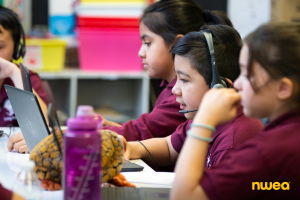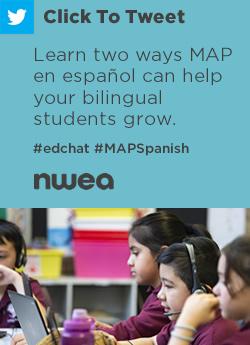 Do you have Spanish speakers in your school?
Do you have Spanish speakers in your school?
Teachers need help identifying what students in one-way and two-way dual language programs are ready to learn. They also need help knowing which kids could benefit from intervention.
MAP® en español makes it easier to do both. How? By allowing students to show what they know in both English and Spanish. Whether you’re a teacher or a school or program leader, using MAP® Growth™ Reading or MAP® Reading Fluency™ in both Spanish and English can help you measure how kids are progressing toward biliteracy and, ultimately, adjust instruction if needed. Here’s how.
1. Assess your dual language classroom
It can be difficult to know when students are reaching proficiency in a second language. MAP Growth and Spanish MAP Growth provide data that can help you see student progress more clearly.
You’ll know it’s time to transition a one-way classroom from Spanish to English when:
- It aligns with an exit or reclassification framework for your district
- Students demonstrate readiness
- The minutes of instruction shift from Spanish to English
If your kids are ready to transition and you’re using MAP Reading Fluency, try administering MAP Growth in English to identify learning targets and MAP Reading Fluency in Spanish to identify any deficits in foundational reading skills. Continuing to build foundational reading skills in Spanish will support the transition to literacy in English.
It can be difficult to know when students are reaching proficiency in a second language, whether you’re in a one-way or two-way dual language classroom.”
If your students are in a two-way dual language program, you can follow a similar process.
Assess students in the second language (L2) to see student progress and growth in L2 reading skills. If biliteracy is a goal, build in opportunities to measure students in both languages. For example, administer assessments in the native language (L1) in the fall, winter, and spring and in the L2 just in spring. Remember to administer the assessment in the same language between terms to measure growth.
Students can also assess between languages with MAP Growth or MAP Reading Fluency.
2. Get support for MTSS and RTI
MAP Growth and Spanish MAP Growth can help with universal screening, too. Assess students in their native language. That will provide a better picture of their skill deficits in reading and/or math. Students whose RIT score range on the MAP Growth K–2 reading assessment is lower in foundational skills may need more support developing their reading skills in their native language before they’re ready to be introduced to more complex texts in the L2.
If biliteracy is a goal, build in opportunities to measure students in both languages.”
 After you’ve completed universal screening, examining the foundational skill areas in MAP Reading Fluency can help you determine specific areas of focus aligned to each student’s zone of proximal development. MAP Reading Fluency links to valuable activities that can help with individual or small group instruction, including resources from the Florida Center for Reading Research.
After you’ve completed universal screening, examining the foundational skill areas in MAP Reading Fluency can help you determine specific areas of focus aligned to each student’s zone of proximal development. MAP Reading Fluency links to valuable activities that can help with individual or small group instruction, including resources from the Florida Center for Reading Research.
Putting the pieces together
Regardless of your program, class enrollment, or participation in tiered supports, MAP Growth and MAP Reading Fluency will give you the actionable data you need to work with your students. The flexibility to choose how to leverage both languages across assessments means you can better pinpoint the learning needs and growth of your students over time, ensuring their path to future success.
Want to learn more about how it all works? Read “Five frequently asked questions about MAP Spanish assessments.”